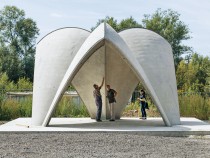
© Ulrich van Stipriaan?/TU Dresden
As a result of the general availability of the raw materials used in its manufacture, its ample load-bearing qualities, its durability and its simple means of production, reinforced concrete became the number-one building material of the past century. In 2014, roughly 4.2 billion tonnes of cement, 28 billion tonnes of aggregate and 2.8 billion tonnes of water were used to create concrete. But that is also its drawback: no other material is responsible for a greater extraction of resources from the earth and for higher CO2 emissions.
Carbon concrete provides scope for more slender forms of construction; and if mat-like textile reinforcement is used, consisting of carbon fibres, a number of concrete structures that were traditionally reinforced with steel could be constructed using the new technology. Furthermore, solid structures in need of repair can be refurbished with additional layers of carbon concrete, thereby increasing their useful life. Carbon- and other textile-reinforced kinds of concrete also lend themselves to the creation of various high quality forms, surface textures and coloration. (Alexander Kahnt, Frank Schladitz, Matthias Tietze, Silke Scheerer, Manfred Curbach)
Carbon concrete provides scope for more slender forms of construction; and if mat-like textile reinforcement is used, consisting of carbon fibres, a number of concrete structures that were traditionally reinforced with steel could be constructed using the new technology. Furthermore, solid structures in need of repair can be refurbished with additional layers of carbon concrete, thereby increasing their useful life. Carbon- and other textile-reinforced kinds of concrete also lend themselves to the creation of various high quality forms, surface textures and coloration. (Alexander Kahnt, Frank Schladitz, Matthias Tietze, Silke Scheerer, Manfred Curbach)
















